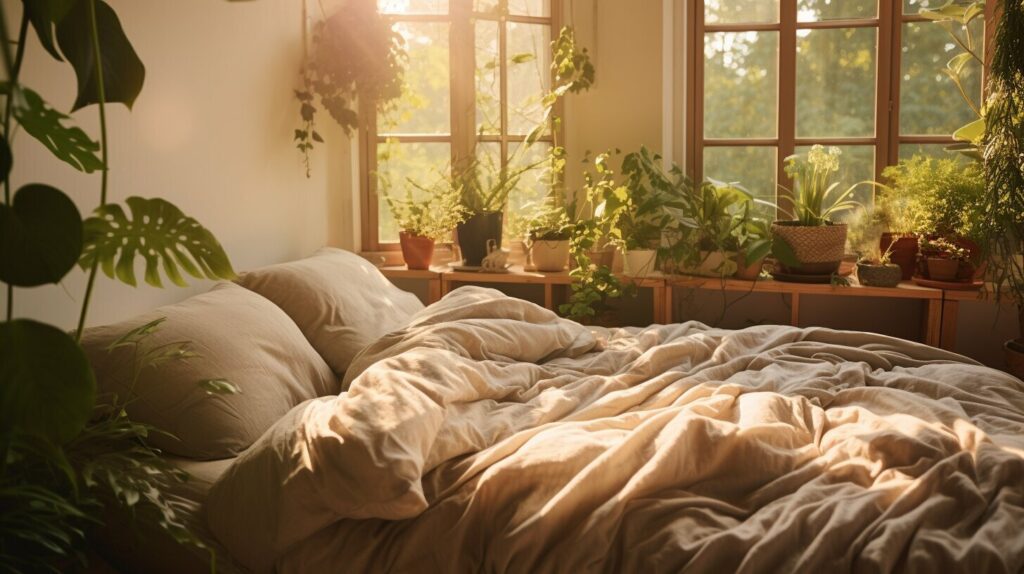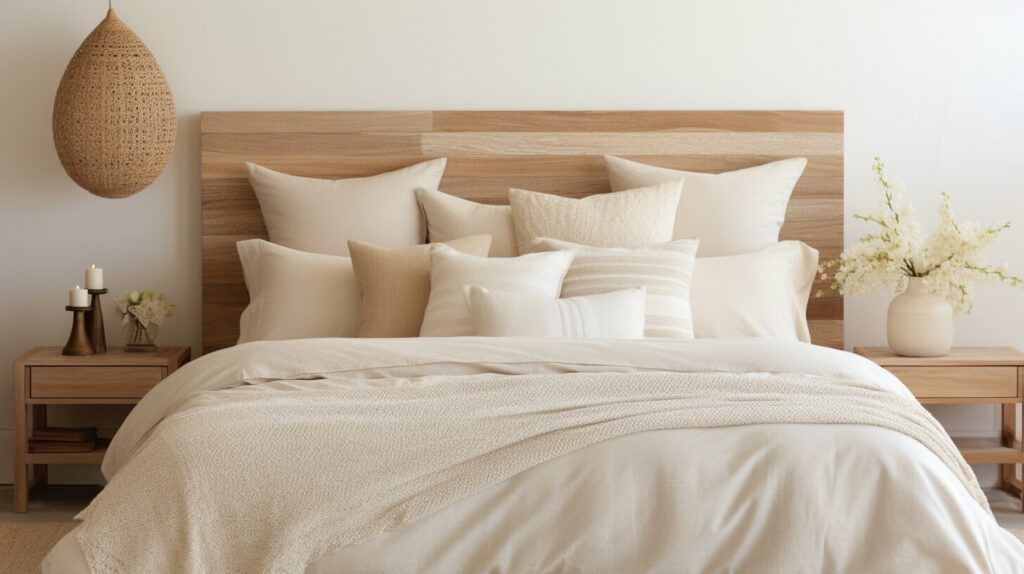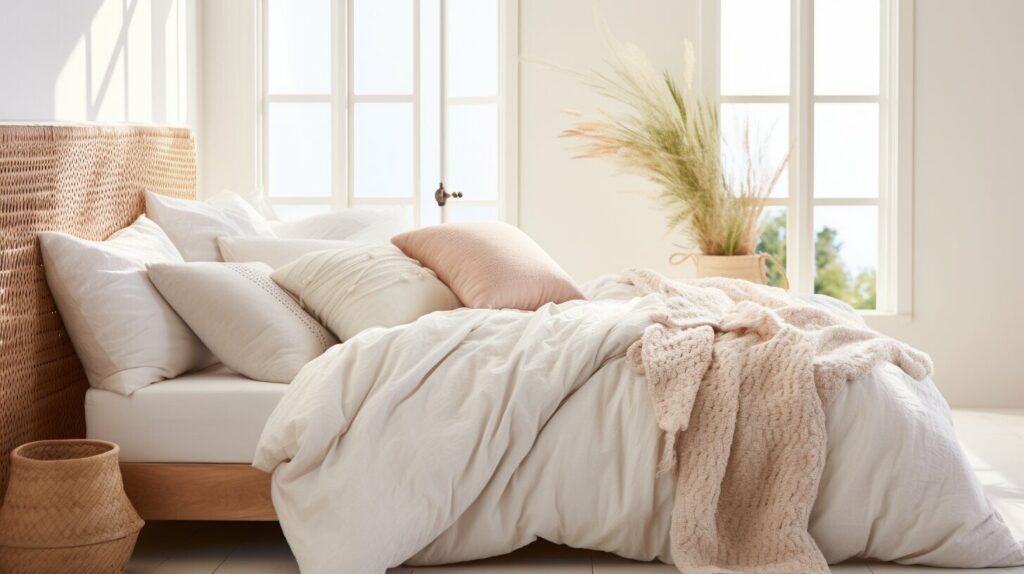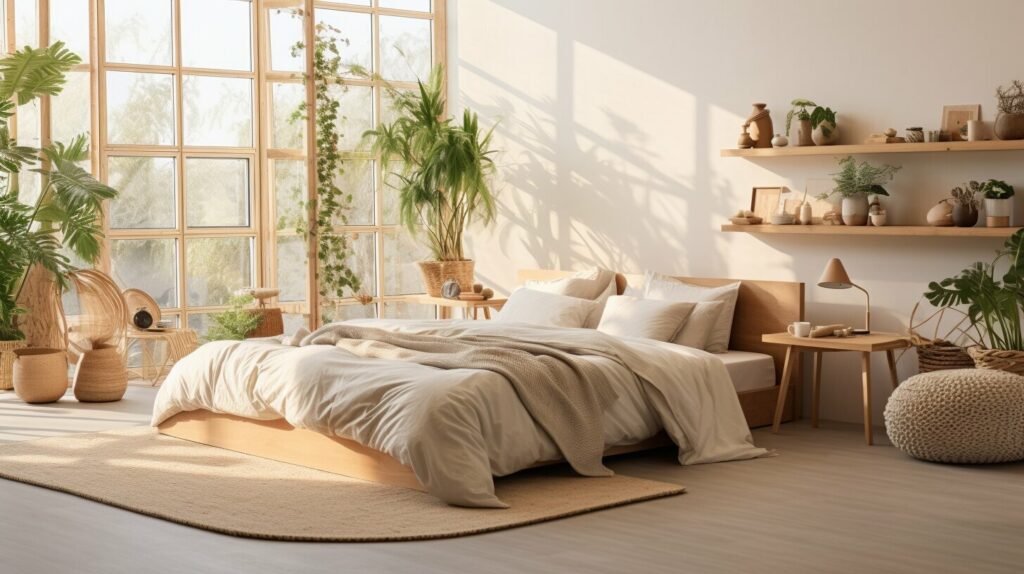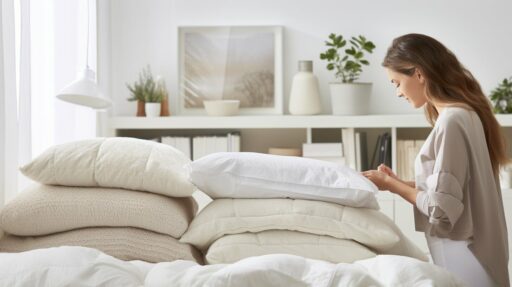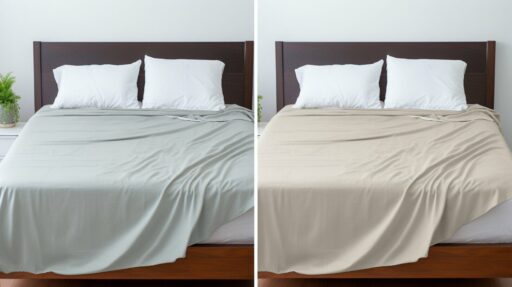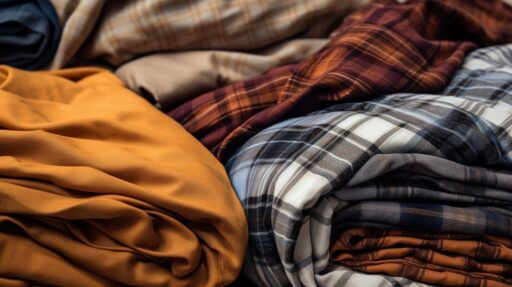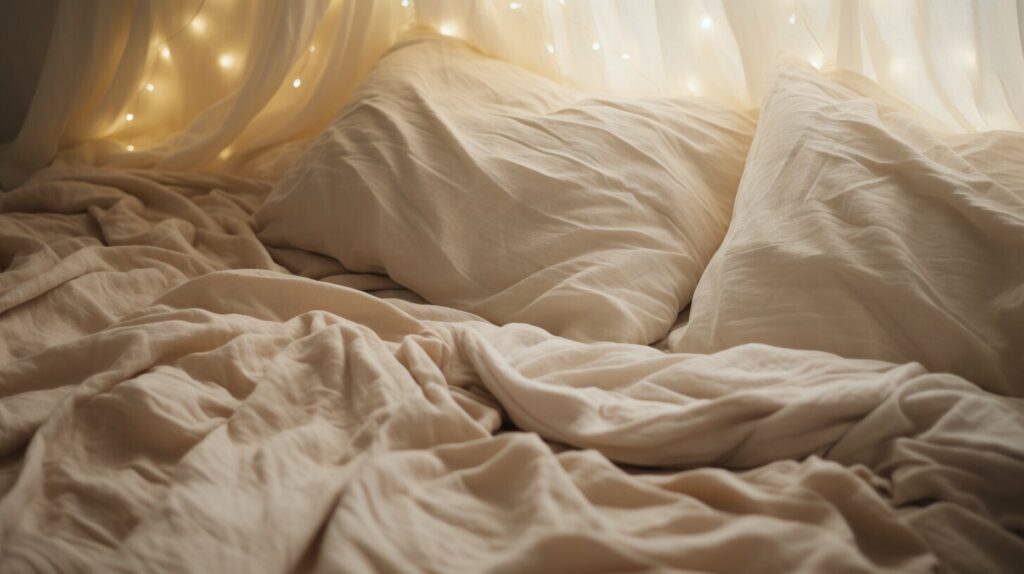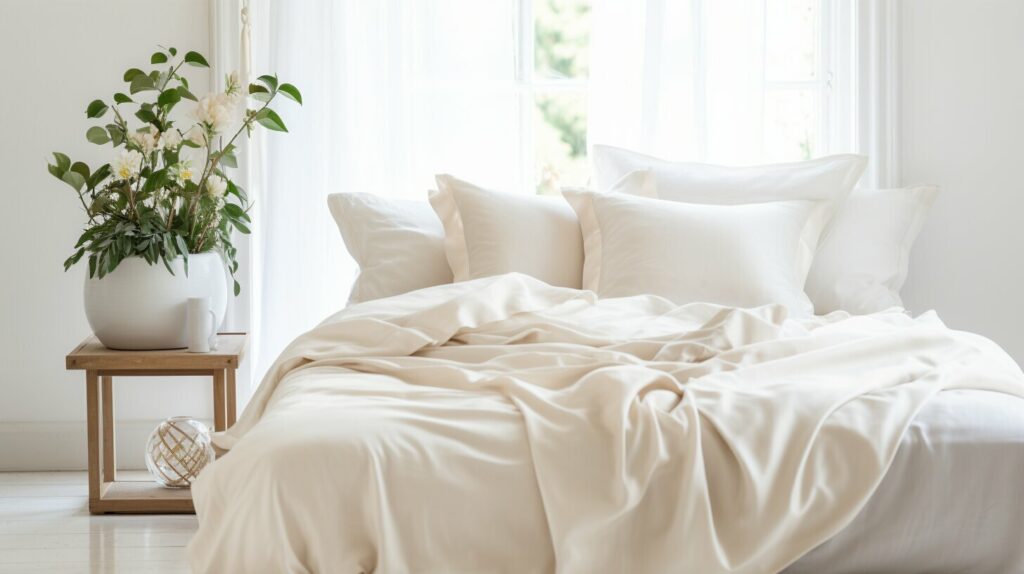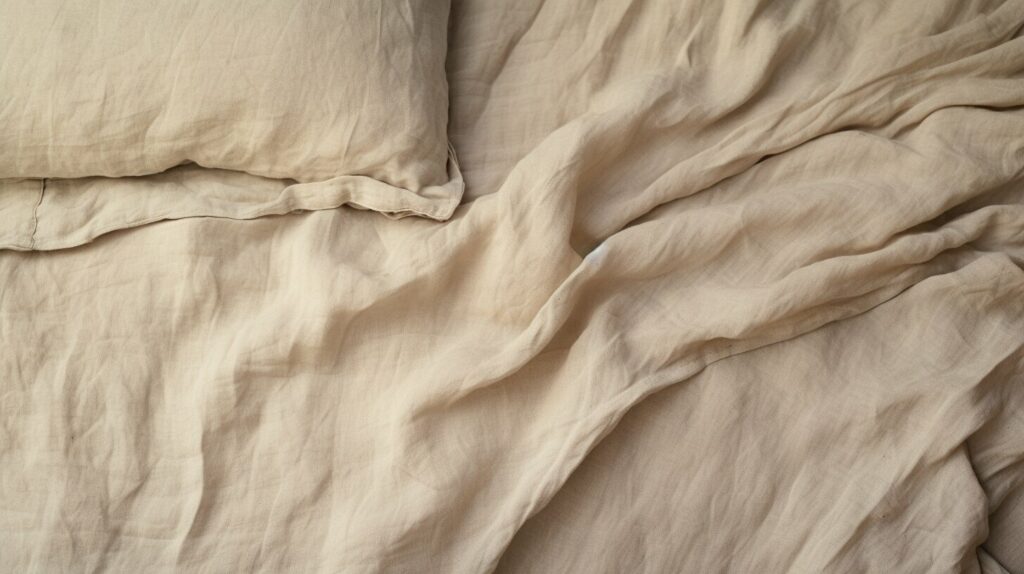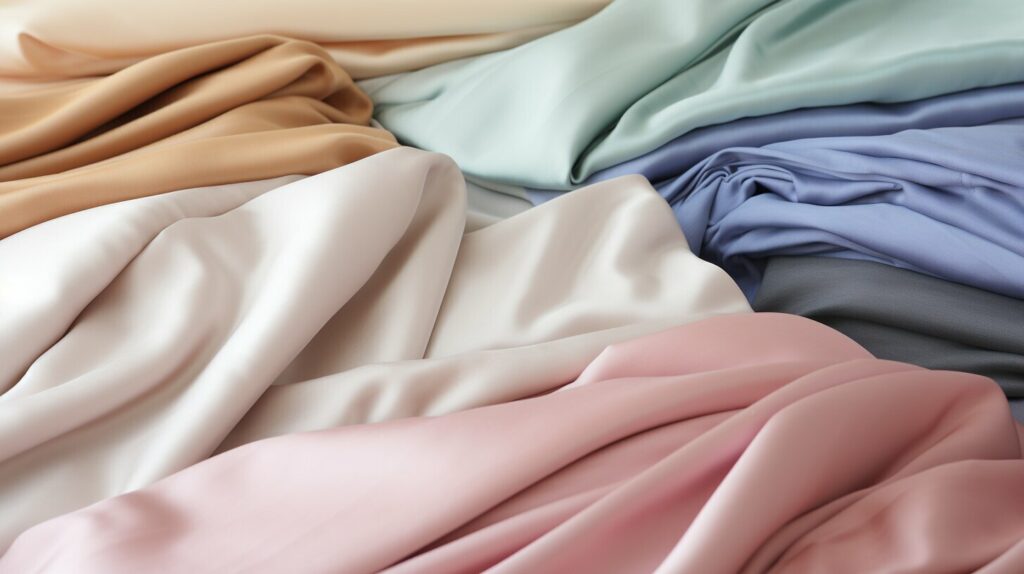The link between your bedding and the quality of your sleep is unmistakable. The selection of the right bed sheets is essential for ensuring comfort and the perfect sleep temperature throughout the night. In an effort to enhance your rest, sleep experts have pinpointed the most conducive materials for optimal slumber. Tencel, cotton, linen, bamboo, and sateen have emerged as the premier choices to cater to a diverse array of sleep needs and preferences. These materials have been thoughtfully chosen for their unique properties, such as moisture-wicking for the warm sleeper or cozy warmth for those who prefer a snugger sleep environment, all to help you drift off with ease.
Key Takeaways:
- There are various types of Bedding Materials Guide available, including Tencel, cotton, linen, bamboo, and sateen.
- Tencel is ideal for hot sleepers due to its moisture-wicking and breathable properties.
- Cotton is popular for its breathability and moisture-wicking abilities.
- Linen offers a cool night’s sleep with its excellent breathability and moisture-wicking properties.
- Bamboo is a hypoallergenic and breathable option that promotes uninterrupted sleep.
- Sateen provides a luxurious feel and is suitable for both hot and cold climates.
Tencel
Tencel, derived from eucalyptus trees, is a great option for hot sleepers. It has tiny hydrophilic fibers that can absorb moisture, making it ideal for those who tend to sleep hot. Tencel is also known for its breathability, lightweight feel, and luxurious qualities, making it a popular choice among sleep experts.
| Benefits of Tencel | Description |
|---|---|
| Moisture-wicking | Tencel sheets have excellent moisture-wicking properties, keeping you cool and dry throughout the night. |
| Breathable | The breathability of Tencel ensures proper airflow, preventing discomfort and sweating during sleep. |
| Lightweight | Tencel sheets have a lightweight feel, providing a comfortable and unrestricted sleep experience. |
For hot sleepers, Tencel offers a combination of moisture-wicking abilities and breathability, ensuring a cool and comfortable night’s rest. Its lightweight nature adds to the overall comfort, allowing you to feel unrestricted while sleeping. Sleep experts recommend Tencel as an excellent choice for those who tend to sleep hot and value a luxurious sleep experience.
“Tencel sheets are a game-changer for hot sleepers. They effectively wick away moisture, keeping you cool and dry throughout the night. Plus, they have a lightweight and luxurious feel that adds to the overall comfort.” – Sleep Expert
Cotton
Cotton is a popular bedding material known for its breathability and moisture-wicking properties. It is a natural fiber that allows air to circulate, keeping you cool and comfortable throughout the night. If you tend to sweat while sleeping, cotton sheets can help absorb moisture and keep you dry. Additionally, cotton is hypoallergenic, making it a great choice for those with allergies or sensitive skin.
When it comes to cotton sheets, organic cotton is highly recommended for its superior breathability and softness. Organic cotton is grown without the use of pesticides, resulting in longer-staple fibers and a more breathable fabric. It is also free from harmful chemicals, making it a healthier option for both you and the environment.
Investing in high-quality cotton sheets can significantly improve your sleep experience. Look for sheets made from 100% cotton with a thread count of 200 or higher for the best combination of breathability, softness, and durability. Keep in mind that cotton sheets may wrinkle more easily compared to other materials, but this can be minimized by drying them properly and using a lower heat setting on your iron.
In summary, cotton is a versatile and comfortable bedding material that offers excellent breathability and moisture-wicking abilities. Organic cotton, in particular, provides superior softness and is a more sustainable option. Consider investing in high-quality cotton sheets to enhance your sleep quality and create a comfortable sleep environment.
Linen: The Key to a Cool Night’s Sleep
When it comes to achieving a comfortable and restful night’s sleep, the type of bedding material you choose can make a significant difference. For those seeking a cool and breathable sleep experience, linen is the answer. With its exceptional breathability and moisture-wicking properties, linen sheets are a popular choice among sleep experts.
Linen, especially when made from high-quality French or Belgian flax, offers superior breathability compared to other materials. The longer fibers in linen create a more open weave, allowing air to circulate freely and prevent heat from becoming trapped. This natural airflow helps regulate your body temperature throughout the night, keeping you cool and comfortable.
Additionally, linen is excellent at moisture-wicking, absorbing moisture from your body and quickly evaporating it into the air. This feature ensures that you stay dry and sweat-free while you sleep, promoting a more comfortable and uninterrupted rest. Linen can absorb up to 20% of its weight in moisture before feeling wet, making it an ideal choice for those prone to night sweats.
| Benefits of Linen | Features |
|---|---|
| Cool and breathable | Regulates body temperature |
| Moisture-wicking | Keeps you dry and comfortable |
| Hypoallergenic | Ideal for those with allergies |
| Durable | Lasts for years with proper care |
| Softens with age | Becomes even more comfortable over time |
Not only does linen excel in its functional properties, but it also adds a touch of natural elegance to your bedroom decor. Its textured and slightly wrinkled appearance gives a relaxed and organic vibe, creating a serene environment for a good night’s sleep. With proper care, linen sheets can last for years, becoming even softer and more comfortable with each use.
So, if you’re looking for a bedding material that will keep you cool, dry, and comfortable throughout the night, linen is the perfect choice. Embrace the breathability and moisture-wicking properties of linen sheets, and experience a truly refreshing and rejuvenating sleep every night.
Bamboo: The Hypoallergenic and Breathable Bedding Material
When it comes to choosing the perfect bedding material, bamboo stands out as an excellent option. Not only is it highly sustainable, but it also offers a range of benefits that can enhance your sleep experience. Bamboo sheets are hypoallergenic, making them ideal for those with sensitive skin or allergies. They are naturally resistant to dust mites and mold, providing a clean and healthy sleeping environment.
In addition to being hypoallergenic, bamboo sheets are exceptionally breathable. The natural fibers of bamboo allow for excellent airflow, enabling heat and moisture to dissipate quickly. This breathability helps regulate your body temperature throughout the night, keeping you cool and comfortable. Whether you’re a hot sleeper or live in a warm climate, bamboo sheets are a great choice to promote a restful sleep.
Bamboo sheets are also known for their moisture-wicking properties. The fibers in bamboo are highly absorbent, drawing moisture away from your body as you sleep. This moisture-wicking ability ensures that you stay dry and comfortable throughout the night, preventing the buildup of sweat and discomfort. With bamboo sheets, you can say goodbye to waking up feeling damp or clammy.

Bamboo Sheets: A Sustainable Choice
Not only do bamboo sheets offer exceptional comfort, but they are also an environmentally friendly option. Bamboo is a fast-growing plant that requires minimal water and no pesticides or fertilizers, making it a highly sustainable material. Choosing bamboo sheets can help reduce your carbon footprint and contribute to a greener planet.
| Benefits of Bamboo Sheets | Benefits of Bamboo Sheets |
|---|---|
| Hypoallergenic | Moisture-wicking |
| Breathable | Sustainable |
| Environmentally friendly | Soft and comfortable |
With its hypoallergenic, breathable, and moisture-wicking properties, bamboo is undoubtedly an excellent choice for bedding material. By opting for bamboo sheets, you can enjoy a comfortable sleep while also making a conscious choice for the environment. Experience the benefits of bamboo and elevate your sleep to a new level of comfort.
Sateen: Breathable, Cooling, and Luxurious
When it comes to luxurious bedding options, sateen is a top choice that offers both style and comfort. Made from 100% cotton, sateen sheets have a unique weave that gives them a smooth and silky appearance, instantly adding a touch of luxury to your bedroom. But sateen isn’t just about aesthetics; it also provides excellent breathability and cooling properties, making it a popular choice for those who prefer a cooler sleep experience.
The breathability of sateen sheets allows for better airflow and helps to regulate body temperature throughout the night. This is especially beneficial for hot sleepers who tend to overheat during sleep. By promoting airflow and dissipating heat, sateen sheets create a more comfortable sleeping environment, resulting in a better night’s rest.
Additionally, sateen sheets have a luxurious feel against the skin, providing a smooth and soft surface to sleep on. The high thread count and tightly woven fabric give sateen sheets a luxurious sheen and a silky texture. This combination of comfort and elegance makes sateen sheets a popular choice for those who want to create a luxurious and inviting bed.

Why choose sateen?
- Breathable and cooling properties.
- Luxurious and silky feel.
- Creates a comfortable sleeping environment.
- Elevates the aesthetic appeal of your bedding.
Whether you’re looking to upgrade your bedding or simply want a more comfortable and luxurious sleep experience, sateen sheets are an excellent choice. With their breathability, cooling properties, and luxurious feel, sateen sheets offer the perfect combination of comfort and style for a truly restful night’s sleep.
What Bedding is Used in 5-Star Hotels?
When it comes to luxury and comfort, 5-star hotels spare no expense in providing their guests with the finest bedding materials. Cotton percale sheets and cotton sateen sheets are the top choices for creating a lavish sleep experience. Let’s take a closer look at these luxurious options.
Cotton Percale Sheets
Cotton percale sheets are synonymous with luxury and comfort. They are known for their breathability, crisp texture, and cool feel. Percale weave creates a matte finish with a tight structure, resulting in a smooth and durable fabric. These sheets have a slightly matte appearance, offering a clean and sophisticated look to any bedding ensemble. The breathable nature of cotton percale sheets provides a comfortable sleep experience by allowing air to circulate, preventing overheating during the night.
Cotton Sateen Sheets
Cotton sateen sheets are another popular choice among 5-star hotels. Sateen weave gives these sheets a lustrous, shiny surface and a silky-smooth feel. The fabric drapes beautifully and is often described as luxurious. Cotton sateen sheets offer a touch of elegance and opulence to any bedroom decor. Despite their shiny appearance, they still provide breathability and a cool feel, making them suitable for year-round use.
Both cotton percale and cotton sateen sheets are crafted from high-quality cotton fibers, which contribute to their exceptional softness and durability. These bedding materials are designed to provide a truly luxurious sleep experience, offering a combination of comfort, breathability, and visual appeal.
| Sheet Type | Features |
|---|---|
| Cotton Percale Sheets | – Breathable – Crisp texture – Cool feel – Matte appearance |
| Cotton Sateen Sheets | – Lustrous and shiny – Silky-smooth feel – Breathable – Cool feel |
Whether you prefer the crispness of cotton percale or the luxurious sheen of cotton sateen, incorporating these bedding materials into your sleep sanctuary can help create a truly indulgent and comfortable atmosphere, reminiscent of a 5-star hotel experience.

Types of Sheets, Explained
When it comes to choosing the perfect sheets for your bed, there are a variety of options to consider. Sheets are made from different materials, each with its own unique qualities and benefits. The type of sheet you choose can greatly impact the breathability, softness, and overall comfort of your sleep experience. Here, we’ll explore the different types of sheets, their materials, weaves, and the characteristics that make them stand out.
Cotton Sheets
Cotton sheets are the most popular choice for bedding due to their breathability and moisture-wicking properties. They offer a comfortable sleep experience and promote airflow, ensuring you stay cool throughout the night. Organic cotton, in particular, is highly recommended for its superior breathability, softness, and sustainability.
Linen Sheets
Linen sheets are known for their exceptional breathability and moisture-wicking capabilities. Made from high-quality flax fibers, linen can absorb moisture while still feeling dry to the touch. It offers a cool night’s sleep in the summer and provides warmth during the colder months. Additionally, linen sheets soften with age and are hypoallergenic, making them a great option for those with sensitive skin or allergies.
Bamboo Sheets
Bamboo sheets are a popular choice for their hypoallergenic properties and excellent breathability. They are moisture-wicking and can absorb three times more water than their weight, keeping you dry and comfortable throughout the night. Bamboo sheets are also a sustainable option, as bamboo grass grows quickly and requires fewer resources compared to other materials.
| Type of Sheet | Materials | Weave | Benefits |
|---|---|---|---|
| Cotton | Cotton fibers | Percale, sateen, twill, jersey | Breathability, moisture-wicking, softness |
| Linen | Flax fibers | Plain, twill, damask | Thermoregulation, durability, softens with age |
| Bamboo | Bamboo-derived rayon | Plain, sateen | Hypoallergenic, breathability, moisture-wicking |
Table: Comparison of Different Types of Sheets
In addition to these popular options, there are also sheets made from materials like polyester, silk, microfiber, and Tencel. Each material has its own unique characteristics and benefits, so it’s important to consider your personal preferences and sleep needs when choosing the right sheets for you. The weave of a sheet, such as percale, sateen, twill, or jersey, can also affect its feel and performance. Experimenting with different types of sheets will help you find the perfect combination of breathability, softness, and comfort for a restful night’s sleep.
What Thread Count Means
When shopping for bed sheets, you may have come across the term “thread count” and wondered what it actually means. Thread count refers to the number of threads per square inch of fabric. It is often used as an indicator of a sheet’s quality and is believed to affect its softness, durability, and breathability.
Traditionally, a higher thread count has been associated with better quality sheets. This is because a higher thread count generally indicates a finer thread and a tighter weave, resulting in a smoother and softer sheet. Sheets with a higher thread count are also believed to be more durable and resistant to pilling.
However, it’s important to note that thread count alone does not determine the overall quality of a sheet. Other factors such as the type of fabric and the weave used also play a significant role in a sheet’s feel and performance. For example, a sheet with a lower thread count made from high-quality cotton may be more comfortable and breathable than a sheet with a higher thread count made from a synthetic material.
When choosing bed sheets, it’s essential to consider your personal preferences and needs. Some people may prefer the softness and luxury feel of sheets with a higher thread count, while others may prioritize breathability and durability. Ultimately, finding the right balance between thread count, fabric type, and weave will help you select sheets that provide the comfort and sleep experience you desire.
In summary, while thread count can be a helpful metric when evaluating bed sheets, it should not be the sole factor in your decision-making process. Consider factors such as fabric type, weave, and personal preferences to ensure you find the perfect sheets that offer the right combination of softness, durability, and breathability for a restful night’s sleep.
Silk
Silk sheets are the epitome of luxury when it comes to bedding materials. The smooth and soft feel of silk against your skin creates a truly indulgent sleep experience. But silk is not just about luxury; it also offers excellent thermoregulation properties. The natural fibers of silk help regulate your body temperature, keeping you cool in the summer and warm in the winter. This means you can enjoy a comfortable night’s sleep throughout the year.
One of the standout features of silk is its moisture-wicking ability. Silk sheets are highly effective at absorbing moisture from your body, keeping you dry and comfortable throughout the night. This is especially beneficial for those who experience night sweats or hot flashes. In addition to its moisture-wicking properties, silk is also naturally breathable, allowing for proper airflow and ventilation.
Another great advantage of silk sheets is their wrinkle-free nature. Silk fibers have a natural resistance to wrinkling, ensuring your bed always looks effortlessly smooth and elegant. This can save you time and effort in ironing or steaming your sheets, giving you more time to enjoy a peaceful night’s sleep.
The Benefits of Silk Sheets:
- Luxurious feel against the skin
- Excellent thermoregulation properties
- Moisture-wicking and breathable
- Wrinkle-free, keeping your bed looking pristine
When it comes to caring for silk sheets, it’s important to follow the manufacturer’s instructions. Silk is a delicate fabric and may require gentle handwashing or dry cleaning. Avoid using harsh detergents or bleach, as this can damage the silk fibers. With proper care, silk sheets can maintain their luxurious qualities for years to come.
| Silk | Cotton | Linen | Bamboo | Sateen | |
|---|---|---|---|---|---|
| Thermoregulation | Excellent | Good | Very Good | Very Good | Good |
| Moisture-wicking | Excellent | Good | Good | Very Good | Good |
| Breathability | Excellent | Very Good | Very Good | Very Good | Very Good |
| Wrinkle-resistance | Yes | No | No | Yes | No |
Linen
Linen is a versatile bedding material known for its exceptional thermoregulation properties. It has the unique ability to keep sleepers warm in winter and cool in summer, making it perfect for year-round use. The natural fibers of linen allow for increased airflow, promoting a comfortable and uninterrupted sleep. Additionally, linen softens with age, becoming even more cozy and inviting over time.
One of the standout features of linen is its durability. Linen sheets are known to withstand frequent washing and everyday use without losing their quality. This makes linen a highly practical and long-lasting investment for your bedding collection. It is also an all-natural option, free from synthetic materials and chemicals, making it a healthier choice for those with allergies or sensitivities.
In summary, linen is a top choice for those looking for bedding that offers excellent thermoregulation, durability, and a softness that improves with time. This all-natural and hypoallergenic material provides a comfortable and restful sleep experience year-round. Consider adding linen sheets to your collection for a luxurious and sustainable bedding option.
Conclusion
By carefully considering the different bedding materials and their benefits, you can significantly improve your sleep comfort and overall sleep quality. Whether you’re a hot sleeper in need of moisture-wicking properties or someone who values breathability, there’s a bedding material out there to meet your specific needs.
Based on expert recommendations, Tencel, cotton, linen, bamboo, and sateen are all excellent options to consider. Tencel is perfect for hot sleepers, thanks to its moisture-absorbing and lightweight qualities. Cotton, especially organic cotton, offers breathability and softness. Linen provides a cool night’s sleep with its superior breathability and moisture-wicking properties. Bamboo is highly recommended for its hypoallergenic nature and moisture-wicking capabilities. Sateen, on the other hand, offers a luxurious and breathable feel.
Investing in high-quality sheets made from these materials can make a world of difference in your sleep experience. Remember to take into account factors such as breathability, moisture-wicking, and personal preferences when making your selection. Don’t underestimate the impact that the right bedding material can have on your sleep comfort and overall well-being.
FAQ
What are the best bedding materials for a restful night’s sleep?
The experts recommend Tencel, cotton, linen, bamboo, and sateen as top choices for different sleep needs and preferences.
What makes Tencel a great option for hot sleepers?
Tencel is derived from eucalyptus trees and has tiny hydrophilic fibers that can absorb moisture. It offers breathability, a lightweight feel, and luxury qualities.
Why is cotton a popular choice for bed sheets?
Cotton is known for its breathability and moisture-wicking abilities. Organic cotton, in particular, is recommended for its superior breathability and softness.
Is linen a good choice for a cool night’s sleep?
Yes, linen, especially linen made from French or Belgian flax, is an excellent choice for a cool night’s sleep. Its longer fibers provide better breathability and moisture-wicking properties.
What are the benefits of bamboo sheets?
Bamboo sheets offer excellent breathability, moisture-wicking properties, and the ability to absorb three times more water than their weight. They are also hypoallergenic and a sustainable choice.
Why is sateen a popular choice for bedding?
Sateen offers breathability, cooling properties, and a luxurious feel. It is suitable for both hot and cold climates and has a smooth and silky appearance.
What bedding materials are commonly used in 5-star hotels?
Most 5-star hotels use cotton sheets, specifically cotton percale or cotton sateen sheets. Percale offers a crisp and cool feel, while sateen has a shiny and silky appearance.
What are the different types of sheet materials and weaves?
Sheets can be made from various materials such as cotton, linen, polyester, bamboo-derived rayon, silk, microfiber, and Tencel. They are woven in different ways, such as percale, sateen, twill, and jersey weaves.
What does thread count mean and how does it affect sheet quality?
Thread count refers to the number of threads per square inch of fabric. A higher thread count generally indicates a softer and more durable sheet, but it’s not the only factor to consider. Material type and weave also play a role in a sheet’s performance.
What are the benefits of silk sheets?
Silk sheets are considered a luxury option known for their smooth feel and temperature-regulating properties. They are hypoallergenic, moisture-wicking, and require specific care.
What are the benefits of linen sheets?
Linen sheets are highly durable and offer excellent thermoregulation properties, keeping sleepers warm in winter and cool in summer. Linen softens with age and is all-natural and hypoallergenic.
How important is choosing the right bedding materials for sleep comfort?
Choosing the right bedding materials is crucial for enhancing sleep comfort and quality. Consider factors such as breathability, moisture-wicking, and personal preferences when selecting bedding materials.



